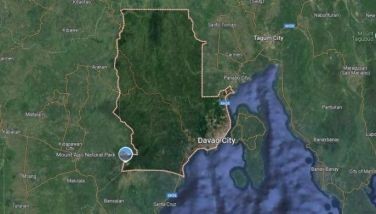Consolidated public sector deficit down to P41.62-B
October 7, 2005 | 12:00am
The Philippines’ combined budget deficits for the government, state-owned companies and institutions such as pension funds narrowed 55.8 percent in the first half of the year, the Department of Finance (DOF) reported yesterday.
The so-called consolidated public-sector deficit (CPSD) fell to P41.62 billion, or 1.5 percent of gross domestic product (GDP), from P94.23 billion a year earlier, reflecting an improvement in the government’s finances, the DOF said in a statement.
President Arroyo wants to wipe out the deficits by 2008 to curb government borrowings. Philippine government debt has almost tripled to P3.9 trillion since 1997, the last time the Philippines posted a surplus in its budget, and interest payments account for a third of the state’s budget.
"We want to end the deficits because we want to make sure that we won’t bequeath the debt burden to the next generation,’’ Finance Assistant Secretary Gil Beltran said.
The public-sector deficit for the first half was less than half the P92.64-billion official estimate for the period. The government has forecast a full- year consolidated deficit of P180.34 billion, less than 2004’s P236 billion.
The government deficit has narrowed 15.7 percent since 1997 to P67.5 billion in the first six months from a year earlier. The gap between revenue and spending for government-owned companies fell 70.6 percent to P9.6 billion.
The two state-run pension funds posted a combined surplus of P23.6 billion in the six-month period, more than double the P10.7 billion a year earlier, the DOF said.
Government-owned lenders have a surplus of P2.5 billion, 37 percent more than the same period in 2004.
The DOF said the improvement in CPSD indicates the continued effort of the government to further improve the economy through more vigorous revenue mobilization and expenditure management.
In particular, the National Government’s budget deficit for the first semester of 2005 amounted to P67.5 billion, below the target of P98.5 by P31 billion.
The improvement against the program comes as a result of better revenue collections and savings in interest payments.
Total public sector borrowing requirement (PSBR) went up to P84.73 billion in end-June 2005 as against the target of P121.04 billion and last year’s P120.58 billion.
On the government corporate side, the 14 GOCCs registered an aggregate deficit of P9.6 billion. This amount represents 22.5 percent of the full year program of P42.5 billion.
The source of savings came largely from lower than program cost to acquire fixed assets for most government corporations coupled with higher than program operating receipts for most of the 14 GOCCs.
The negative cash positions of NG and GOCCs were offset by the improved financial standing of the SSIs specifically GSIS, which was able to register the biggest surplus of P13.7 billion.
This is on the account of the bigger revenues earned from the members’ contributions and the investment income and other earnings such as from holdings of NG securities.
The so-called consolidated public-sector deficit (CPSD) fell to P41.62 billion, or 1.5 percent of gross domestic product (GDP), from P94.23 billion a year earlier, reflecting an improvement in the government’s finances, the DOF said in a statement.
President Arroyo wants to wipe out the deficits by 2008 to curb government borrowings. Philippine government debt has almost tripled to P3.9 trillion since 1997, the last time the Philippines posted a surplus in its budget, and interest payments account for a third of the state’s budget.
"We want to end the deficits because we want to make sure that we won’t bequeath the debt burden to the next generation,’’ Finance Assistant Secretary Gil Beltran said.
The public-sector deficit for the first half was less than half the P92.64-billion official estimate for the period. The government has forecast a full- year consolidated deficit of P180.34 billion, less than 2004’s P236 billion.
The government deficit has narrowed 15.7 percent since 1997 to P67.5 billion in the first six months from a year earlier. The gap between revenue and spending for government-owned companies fell 70.6 percent to P9.6 billion.
The two state-run pension funds posted a combined surplus of P23.6 billion in the six-month period, more than double the P10.7 billion a year earlier, the DOF said.
Government-owned lenders have a surplus of P2.5 billion, 37 percent more than the same period in 2004.
The DOF said the improvement in CPSD indicates the continued effort of the government to further improve the economy through more vigorous revenue mobilization and expenditure management.
In particular, the National Government’s budget deficit for the first semester of 2005 amounted to P67.5 billion, below the target of P98.5 by P31 billion.
The improvement against the program comes as a result of better revenue collections and savings in interest payments.
Total public sector borrowing requirement (PSBR) went up to P84.73 billion in end-June 2005 as against the target of P121.04 billion and last year’s P120.58 billion.
On the government corporate side, the 14 GOCCs registered an aggregate deficit of P9.6 billion. This amount represents 22.5 percent of the full year program of P42.5 billion.
The source of savings came largely from lower than program cost to acquire fixed assets for most government corporations coupled with higher than program operating receipts for most of the 14 GOCCs.
The negative cash positions of NG and GOCCs were offset by the improved financial standing of the SSIs specifically GSIS, which was able to register the biggest surplus of P13.7 billion.
This is on the account of the bigger revenues earned from the members’ contributions and the investment income and other earnings such as from holdings of NG securities.
BrandSpace Articles
<
>
- Latest
- Trending
Trending
Latest
Trending
Latest
Recommended




























